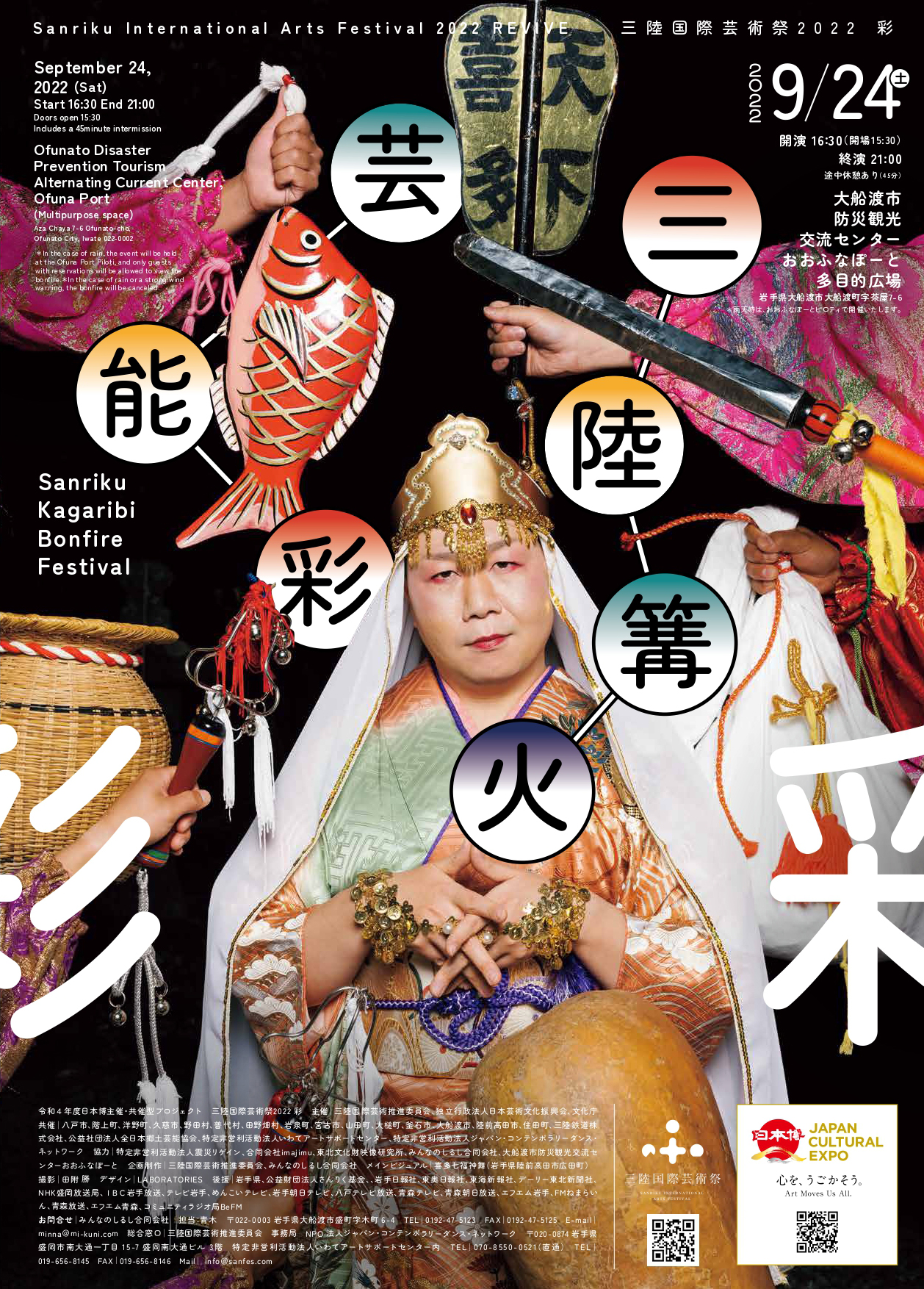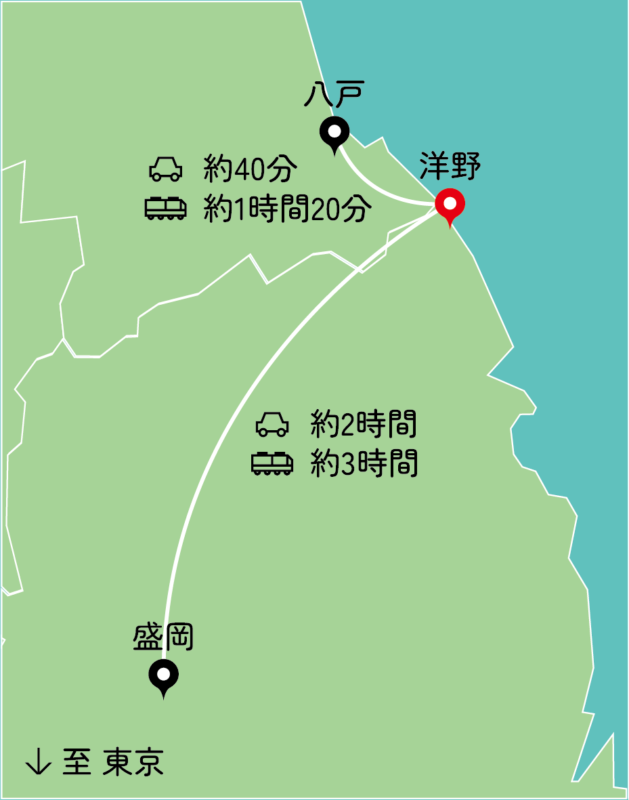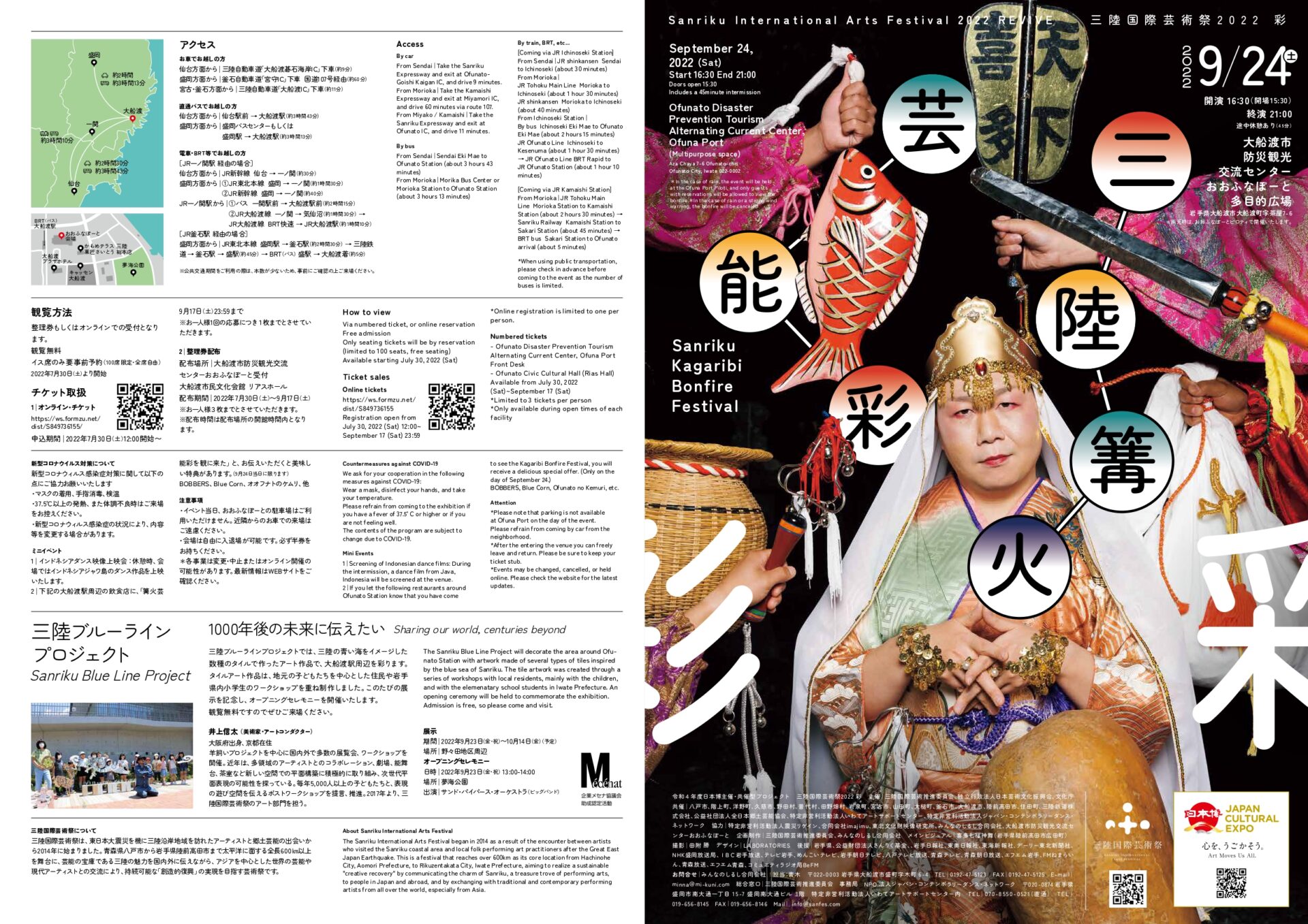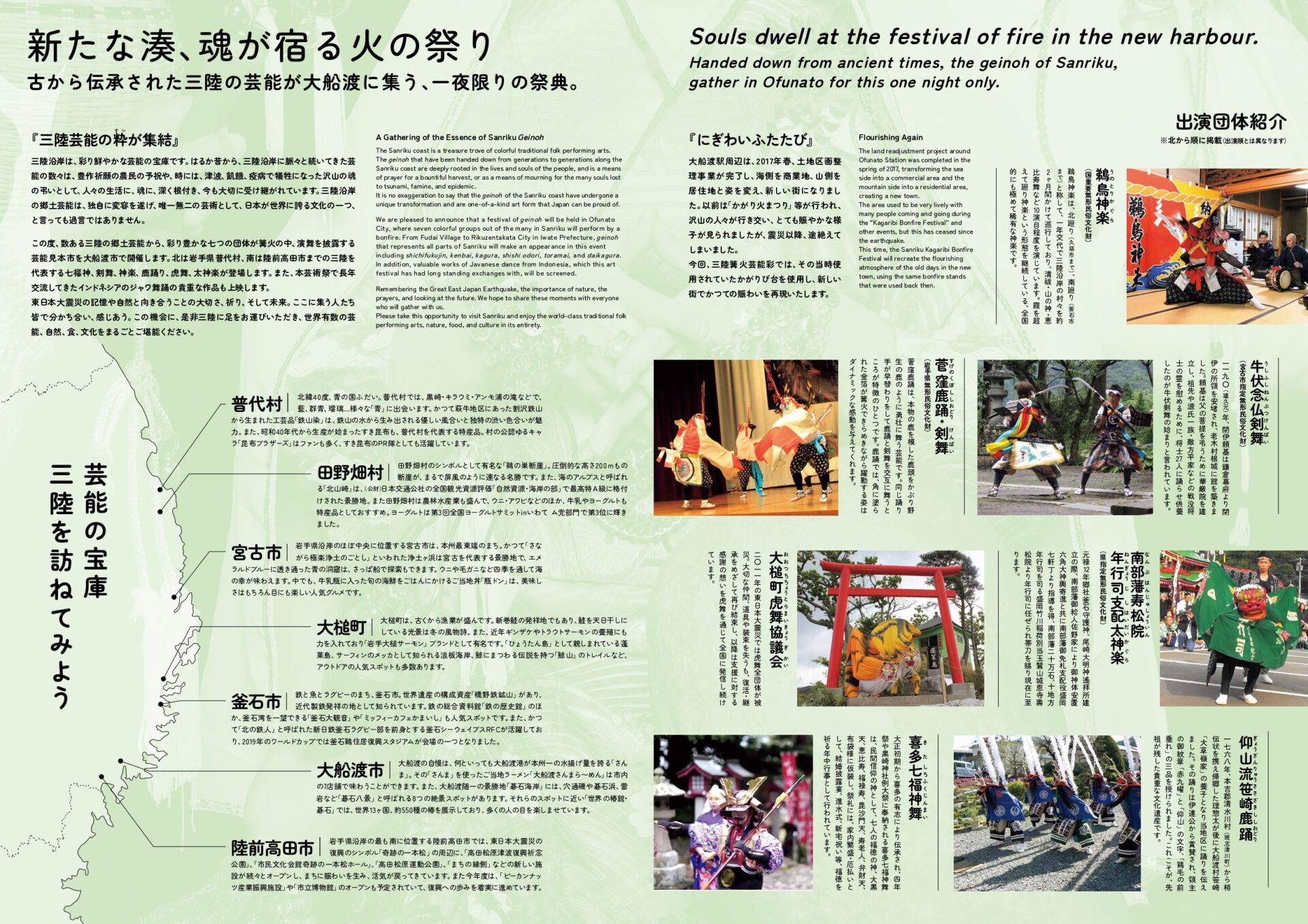EVENT
Sanriku Kagaribi Bonfire Festival Sep.24th,2022
- 2022
- Appreciation
-
Date
September 24, 2022 (Sat)
-
Time
Start 16:30 End 21:00 (Doors open 15:30) (Includes a 45minute intermission)
-
Locate
Ofunato Disaster Prevention Tourism Exchange Center, Ofuna Port (Multipurpose space)※In the case of rain, the event will be held at the Ofuna Port Piloti, and only guests with reservations will be allowed to view the bonfire.
-
Fee
Free admission

A luxurious time to savor the geinoh of Sanriku in the magical atmosphere of a kagaribi bonfire.
A festival of geinoh in Ofunato City, where seven colorful groups from the Sanriku coastal region of the Tohoku will perform by a bonfire!
From Fudai Village to Rikuzentakata City in Iwate Prefecture, geinoh that represents all parts of Sanriku will make an appearance in this event including shichifukujin, kenbai, kagura, shishi odori, toramai, and daikagura. In addition, valuable works of Javanese dance from Indonesia, which this art festival has had long standing exchanges with, will be screened.
Please enjoy the Sanriku Kagaribi Bonfire Festival, a unique coloring of the Sanriku International Arts Festival.
Where are the geinoh from, in Sanriku?
- 16:40 Tanohata Village, Iwate Prefecture|Sugenokubo Shishiodori / Kenbai
- 17:05 Miyako City, Iwate Prefecture|Ushifushi Nembutsu Kenbai
- 17:35 Fudai Village, Iwate Prefecture|Unotori Kagura
- 19:00 Kamaishi City, Iwate Prefecture|Nambuhan Jushoin Nengyoji Shihai Daikagura
- 19:25 Rikuzentakata City, Iwate Prefecture|Kita Shichifukujinmai
- 19:40 Otsuchi Town, Iwate Prefecture|Otsuchi-cho Toramai Kyogikai
- 20:10 Ofunato City, Iwate Prefecture|Gyozanryu Sasazaki Shishiodori
■Mini Events■
1) Screening of Indonesian dance films: During the intermission, a dance film from Java, Indonesia will be screened at the venue.
2) If you let the following restaurants around Ofunato Station know that you have come to see the Kagaribi Bonfire Festival, you will receive a delicious special offer. (Only on the day of September 24.)
BOBBERS, Blue Corn, Ofunato no Kemuri, etc.
■Ticket information■
Free admission
Only seating tickets will be by reservation (limited to 100 seats, free seating)
– Reservation
Available starting July 30, 2022 (Sat)
Via numbered ticket, or online reservation
Ticket sales
– Online tickets: https://ws.formzu.net/dist/S849736155
QR code
Registration open from July 30, 2022 (Sat) 12:00~September 17 (Sat) 23:59
*Online registration is limited to one per person.
Numbered tickets
Available from July 30, 2022 (Sat)~September 17 (Sat)
– Ofunato Disaster Prevention Tourism Alternating Current Center, Ofuna Port Front Desk
– Ofunato Civic Cultural Hall (Rias Hall)
*Limited to 3 tickets per person
*Only available during open times of each facility
■What is the geinoh of Sanriku?■
The Sanriku coast is a treasure trove of colorful traditional folk performing arts.
The geinoh that have been handed down from generations to generations along the Sanriku coast are deeply rooted in the lives and souls of the people, and is a means of prayer for a bountiful harvest, or as a means of mourning for the many souls lost to tsunami, famine, and epidemic.
It is no exaggeration to say that the geinoh of the Sanriku coast have undergone a unique transformation and are one-of-a-kind art form that Japan can be proud of.
In the Great East Japan Earthquake, a huge tsunami swallowed the streets of Sanriku. In the midst of sadness, one source of emotional support was geinoh.
Flourishing Again
The land readjustment project around Ofunato Station was completed in the spring of 2017, transforming the sea side into a commercial area and the mountain side into a residential area, creating a new town.
The area used to be very lively with many people coming and going during the “Kagaribi Bonfire Festival” and other events, but this has ceased since the earthquake.
This time, the Sanriku Kagaribi Bonfire Festival will recreate the flourishing atmosphere of the old days in the new town, using the same bonfire stands that were used back then.
■Venue information■
■access■

By car:
From Sendai: Take the Sanriku Expressway and exit at Ofunato-Goishi Kaigan IC, and drive 9 minutes.
From Morioka: Take the Kamaishi Expressway and exit at Miyamori IC, and drive 60 minutes via route 107.
From Miyako / Kamaishi: Take the Sanriku Expressway and exit at Ofunato IC, and drive 11 minutes.
By bus:
From Sendai: Sendai Eki Mae to Ofunato Station (about 3 hours 43 minutes)
From Morioka: Morika Bus Center or Morioka Station to Ofunato Station (about 3 hours 13 minutes)
By train, BRT, etc…:
Coming via JR Ichinoseki Station
From Sendai
JR shinkansen Sendai to Ichinoseki (about 30 minutes)
From Morioka
JR Tohoku Main Line Morioka to Ichinoseki (about 1 hour 30 minutes)
JR shinkansen Morioka to Ichinoseki (about 40 minutes)
From Ichinoseki Station:
By bus: Ichinoseki Eki Mae to Ofunato Eki Mae (about 2 hours 15 minutes)
JR Ofunato Line Ichinoseki to Kesenuma (about 1 hour 30 minutes)
>>>> JR Ofunato Line BRT Rapid to JR Ofunato Station (about 1 hour 10 minutes)
Coming via JR Kamaishi Station
From Morioka
JR Tohoku Main Line Morioka Station to Kamaishi Station (about 2 hours 30 minutes)
>>> Sanriku Railway Kamaishi Station to Sakari Station (about 45 minutes)
>>>BRT bus Sakari Station to Ofunato arrival (about 5 minutes)
*When using public transportation, please check in advance before coming to the event as the number of buses is limited.
■Attention■
In the case of rain, the event will be held at the Ofuna Port Piloti, and only guests with reservations will be allowed to view the bonfire.
In the case of rain or a strong wind warning, the bonfire will be canceled.
In the case of stormy weather, the event will be canceled.
In the case of inclement weather, the event will be announced on the day of the event via the Sanriku International Arts Festival’s official SNS.
Concurrent event:Sanriku Blue Line Project ~Sharing our world, centuries beyond~
Sanriku Kagaribi Bonfire Festival leaflet


■Contact■
Minna no Shirushi LLC (POC: Aoki)
6-4 Aza Kimachi Sakari-cho, Ofunato City, Iwate 022-0003
TEL | 0192-47-5123 FAX | 0192-47-5125
E-mail | minna@mi-kuni.com
Areas
Artists
-
Sugenokubo Shishiodori/Kenbai
The Sugenokubo Shishiodori is a dance imitating wild deer’s vigorous motion with deer-shaped headdress.
In ancient time, when Takemikazuchi-no-mikoto landed on the shore of Lake Kasumigaura in Ibaraki prefecture and the native people attempted to kill him by setting fire to the field, numerous deer showed up, repeatedly plunged into the water and ran around to extinguish the fire. Deeply moved to see this, Mikoto created the shishiodori.
It is unique to the Sugenokubo school that shishiodori and kenbai are performed swiftly interchanging. The dance is impressive in its dynamism of dancing with the gilt on the deer horns which sparkles reflecting the fire.
It is designated as the Intangible Folk Cultural Property by Iwate prefecture in 1988. -
Ushifushi Nenbutsu Kenbai
In 1190, Chinzei Hachiro Tametomo’s third son, Minamoto no Tameyori, was granted his territory in Hei and Kesen by Minamoto no Yoritomo, the first shogun of the Kamakura shogunate. He built a castle in Nejo, Roki, and took on the name of Hei Yorimoto.
Yorimoto built Kegon-in temple in dedication to the soul of his father, where he had 27 soldiers dance for the souls of ancestors and of the Minamoto clan and also of its rival Taira clan killed in the war. This is believed to be the origin of the Ushifushi Kembai.
During the annual Bon Festival in August, the dancers go around houses in the area to appease the souls of ancestors and the recently departed. On the 16th, it ritually performs its kembai and nanatsu-odori (seven-item dance) at the Kegon-in temple in Kebaraichi to pray for the dead. -
Unotori Kagura Preservation Society
The Unotori Kagura is a typical yamabushi (mountain hermit) kagura. It worships shishigashira into which the spirit from Unotori Shrine in Torii, Fudai village entered. It tours villages to pray for a rich haul, a bountiful crop and safety of family from January to March every year. The tour proceeds in Iwate, northbound to Kuji city and southbound to Kamaishi city in alternating years. Local residents host the kagura intimately calling “Unotori sama.” Since this form of the tour is unique and it maintains rare customs, Unotori Kagura is designated as the Intangible Folk Cultural Property by the state in 2015.
-
Nanbuhan jyusyoin Nengyoji Daikagura
In 1688, when the shrine of Ozaki Daimyojin, the guardian deity of Kamaishi, was built, the Sano family, the official paymaster of the Nambu domain, donated a large hexagonal portable shrine in which the sacred body was enshrined, and received guidance from Morioka Shichikencho, the Nambu domain’s official bill administrator. They were then officially appointed as a nengyoji annual leader by Jushoin temple which, in charge of rituals for Takegawa Inari Shrine in Morioka, presides over ten regional nengyoji in the Nambu domain.
-
Kita Shichifukujin
The Shichifukujin-mai of Kita represents the seven gods of good fortune, popular gods in folk belief named Daikokuten, Ebisu, Fukurokuju, Bishamonten, Jurojin, Benzaiten and Hotei. It is performed in festivals held to pray for good harvest and big catches in the sea, and also on occasions year-round to pray for prosperity and exorcism at such celebratory events as wedding parties, new home construction and the launchings of new sea vessels. It has been handed down by volunteers from Kita since the 1910’s, and performed for the annual festival of Kurosaki Shrine, including the O-Ise-sama (aka Daijingu-sama) Festival held once every four years. In recent years, the Shichifukujin-mai of Kita has been practiced as a folk art by local elementary and middle school children as well.
-
Otsuchi Toramai Kyogikai
The troupe was formed as toramai section in the association of the preservation societies of the folk performing arts in Otsuchi town in 1990. Comprised of four toramai groups in the town; Ando, Mukaigawara, Rikuchubenten and Otsuchi-Shiroyama, the troupe aims at cultivation of friendship between the groups, mutual empowerment and social contribution.
The great earthquake of March 2011 damaged all the four groups. Overcoming the loss of the fellow members, the costumes and other equipment, they reunited for the revival and transmission. They have been actively performing the dance nationwide since then, to show their gratitude for help and support they received. In their repertory are Yaguruma, Hanetora, Sasabami, Jinkuodori, and Teodori among others. -
Gyozanryu Sasazaki Shishiodori Preservation Society
In 1768, a man named Risota returned home from Shizugawa village (today,Minamisanriku Town,Motoyoshi District,Miyagi Prefecture) in Motoyoshi district, bearing a scroll certifying him as the inheritor of this dance. He was later adopted by the Osorei family in Sasazaki, Ofunato, and introduced the dance to the district. The chief of the Date clan praised the dance and granted Risota the akakuyo (red nine-star) crest of a fief-holder, the epithet of “gyozan,” (which means “rare,” “extraordinary”) and the frontal cloth with bird feathers. This is the precious ancestral heritage.
Sanriku International Arts Festival 2022 REVIVE
– An FY 2022 Japan Cultural Expo Project Presented and Co-presented by Japan Arts Council and Agency for Cultural Affairs, Government of Japan

Organized by|Sanriku International Arts Committee, Japan Arts Council, and Agency for Cultural Affairs, Government of Japan
Co-organized by|Hachinohe City, Hashikami Town, Hirono Town, Kuji City, Noda Village, Fudai Village, Tanohata Village, Iwaizumi Town, Miyako City, Yamada Town, Otsuchi Town, Kamaishi City, Ofunato City, Rikuzentakata City, Sumita Town, Sanriku Railway Co., Ltd., Japan Folk Performing Arts Association, NPO Iwate Arts Support Center, and NPO Japan Contemporary Dance Network
Cooperated by|NPO Shinsai Regain, imajimu LLC, Tohoku Cultural Property Video Research Institute, Minna no Shirushi LLC, and Ofunato Disaster Prevention Tourism Alternating Current Center Ofuna Port